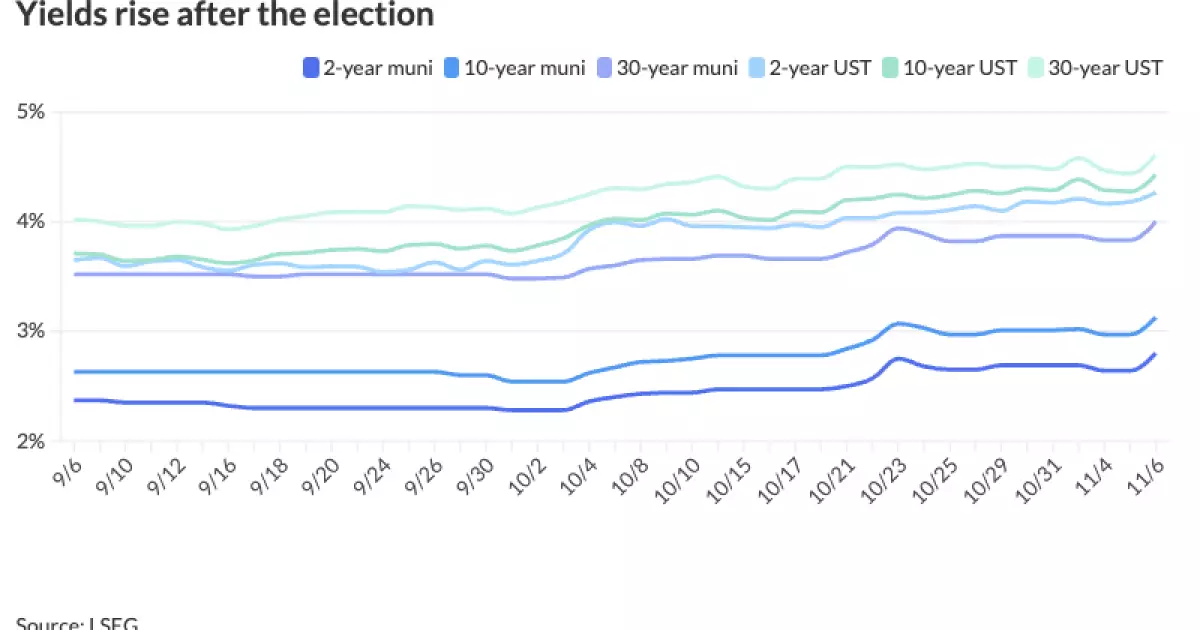In recent months, the landscape of municipal bonds and treasury yields has shifted dramatically due to a significant political upheaval. Following the recent elections, where former President Donald Trump regained substantial influence, the markets experienced a ripple effect that reverberated through the fixed income arena. Investors confronted a multifaceted scenario: rising yields, heightened risk assessments, and a looming uncertainty regarding fiscal policies under a new Republican administration.
The immediate aftermath of the elections saw a stark sell-off in municipal bonds. With Trump emerging victorious in a manner that many did not anticipate, market behavior reflected a newfound appetite for risk—the so-called ‘risk-on’ trade. The municipal market followed suit with U.S. Treasuries, resulting in an increase in yields across the board. The minute details were illuminated by the rise in municipal triple-A yield curves, which surged between 11 to 17 basis points. Conversely, the U.S. Treasury (UST) yields echoed similar sentiments, witnessing increases of 9 to 17 basis points.
Financial markets are significantly impacted by political winds, and the recent red wave—a term used to describe the Republican Party’s dominance—raised concerns among investors. This paradigm shift led to a recalibration of expectations regarding fiscal policies and economic indicators, which are now viewed through a lens of potential growth paired with rising inflation. The excitement generated by the red wave, juxtaposed with the historical context of previous administrations, has created a volatile atmosphere encouraging investors to reassess their strategies.
Analysts have pointed out an anticipated increase in growth rates as a positive outcome from these political changes. However, with growth comes the inevitability of higher real yields. Recent research from BMO Capital Markets indicated that the increasing supply of U.S. Treasury bonds to finance escalating deficits is likely to exert upward pressure on nominal yields. This has left market participants grappling with the implications of a radical change in monetary conditions—one that could signify long-term shifts in fiscal policies.
While institutional investors remain cautious, some are adopting a more optimistic view of the evolving marketplace. With the expectation of low issuance in municipal bond transactions, liquidity could become scarce, further exacerbating volatility. The precarious balancing act between the push for infrastructure spending and potential tax cuts under new leadership means that bond yields may not settle back below thresholds previously considered comfortable, particularly given the increasing credit risks associated with these new policies.
The Broader Implications for Fed Policy
The Federal Reserve’s approach in light of these developments is a critical area of scrutiny. As discussions around potential interest rate cuts loom, economists have posited that the Fed’s monetary policy will need to tread carefully to avoid destabilizing the newfound economic dynamics. Analysts expect a reduction of rates by 25 basis points in an upcoming meeting, signaling a move towards a more accommodative approach.
However, this anticipation comes with a caveat—the Fed may not react as promptly or aggressively to fiscal stimuli, such as tax cuts, if inflationary pressures commence. Contrarily, tariffs, which could escalate under a Trump administration, have historically produced supply shocks that complicate the Fed’s ability to control inflation through interest rate adjustments. Consequently, markets are speculating on multiple tariff scenarios, further adding layers of complexity to the economic forecasting landscape.
The Market’s Uncertainty and the Road Ahead
As traders digest these political changes, they remain aware of the critical balancing act between growth and inflation. Managing the potential repercussions of tax cuts while navigating the risk of tariffs will be a tightrope walk for the new administration. Market insights suggest that the municipal bonds could react favorably to a broadening demand pattern that aligns with infrastructure developments. The anticipated shift from tax-exempt munis into the taxable market raises concerns about widening spreads, which could factor into future pricing for these bonds.
The immediate future of municipal bonds and U.S. Treasury yields is intertwined with a turbulent political landscape and the economic implications that accompany it. As investors recalibrate their expectations amid turbulent waters, the overall climate forsakes comfort in favor of cautious optimism. The path forward will be determined by the balance struck between monetary policy responses and the fiscal imperatives introduced by a new set of governmental priorities. The complexities of this environment afford ample opportunities for those attuned to the emerging trends—a dynamic worth closely monitoring as we advance.

